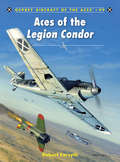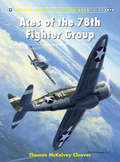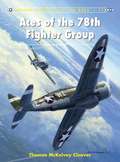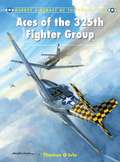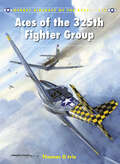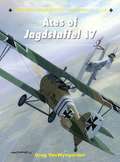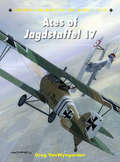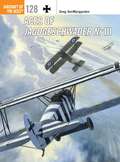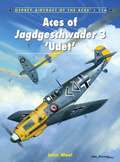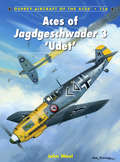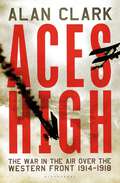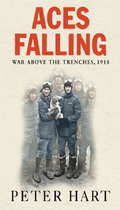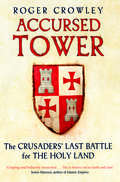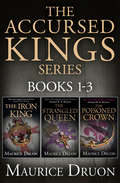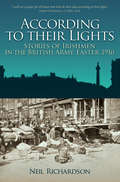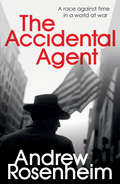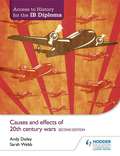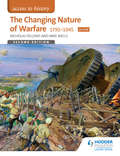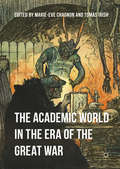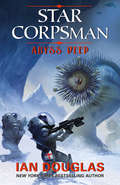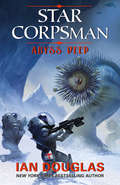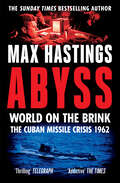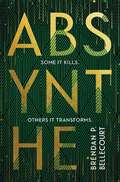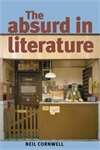- Table View
- List View
Aces of the Legion Condor (Aircraft of the Aces #99)
by Jim Laurier Robert ForsythFor Germany, the Spanish Civil War proved a perfect testing ground for new technologies and tactics. During the war, some 19,000 German 'volunteers' formed an aviation group called the Legion Condor in support of the fascists. Originally flying He-51s, they were soon upgraded to 109s. These fighters proved dominant in the Spanish skies, and many members of the legion scored five or more kills during the fighting.
Aces of the 78th Fighter Group (Aircraft of the Aces #115)
by Thomas McKelvey Cleaver Mr Chris DaveyDubbed the 'Eagles of Duxford', the 78th Fighter Group (FG) was unique in being the only fighter unit in the 'Mighty Eighth' to fly the P-38 Lightning, P-47 Thunderbolt and P-51 Mustang operationally. Arriving in the European Theatre of Operations (ETO) in November 1942, and eventually committed to combat five months later, the 78th, along with the 4th and 56th FGs, 'wrote the book' on long-range fighter escort by VIII Fighter Command in the ETO. This volume charts the group's highs and lows during its two years in action from Duxford, focusing on the exploits of the 51 pilots who achieved ace status with the 78th during World War 2. These men included Capt Charles London, the very first Eighth Air Force ace, and Maj Quince Brown, who was the 78th's most successful aerial ace prior to being murdered by the SS after he was shot down over Germany. By VE Day, the 'Eagles of Duxford' had downed 316 aircraft and destroyed a further 320 machines on the ground during strafing attacks on German airfields.
Aces of the 78th Fighter Group (Aircraft of the Aces)
by Chris Davey Thomas McKelvey CleaverDubbed the 'Eagles of Duxford', the 78th Fighter Group (FG) was unique in being the only fighter unit in the 'Mighty Eighth' to fly the P-38 Lightning, P-47 Thunderbolt and P-51 Mustang operationally. Arriving in the European Theatre of Operations (ETO) in November 1942, and eventually committed to combat five months later, the 78th, along with the 4th and 56th FGs, 'wrote the book' on long-range fighter escort by VIII Fighter Command in the ETO. This volume charts the group's highs and lows during its two years in action from Duxford, focusing on the exploits of the 51 pilots who achieved ace status with the 78th during World War 2. These men included Capt Charles London, the very first Eighth Air Force ace, and Maj Quince Brown, who was the 78th's most successful aerial ace prior to being murdered by the SS after he was shot down over Germany. By VE Day, the 'Eagles of Duxford' had downed 316 aircraft and destroyed a further 320 machines on the ground during strafing attacks on German airfields.
Aces of the 325th Fighter Group (Aircraft of the Aces)
by Chris Davey Tom IvieThe 325th FG was activated under General Order number 50 on 30 July 1942 and set up training operations at Theodore F Greene Field in Providence, Rhode Island. By mid-December 1942 the group was considered ready for combat and the alert for overseas duty arrived on 2 January 1943. The pilots and their P-40s departed on the carrier USS Ranger on 8 January and flew their aircraft off the vessel into Cazes airfield, near Casablanca, on 19 January 1943. After the remainder of the personnel arrived in late February, the group prepared for combat, and finally flew its first mission on 17 April 1943 as part of the Twelfth Air Force. During the next four months it participated in the North African campaign, and operations against enemy-held islands in the Mediterranean Sea. By the end of the Sicilian campaign on 17 August the 325th FG had scored 128 aerial victories, been the first P-40 unit to deliver 1,000-lb bombs against enemy targets and had escorted 1,100 bombers without losing a single one of them to enemy action.
Aces of the 325th Fighter Group (Aircraft of the Aces #117)
by Tom IvieThe 325th FG was activated under General Order number 50 on 30 July 1942 and set up training operations at Theodore F Greene Field in Providence, Rhode Island. By mid-December 1942 the group was considered ready for combat and the alert for overseas duty arrived on 2 January 1943. The pilots and their P-40s departed on the carrier USS Ranger on 8 January and flew their aircraft off the vessel into Cazes airfield, near Casablanca, on 19 January 1943. After the remainder of the personnel arrived in late February, the group prepared for combat, and finally flew its first mission on 17 April 1943 as part of the Twelfth Air Force. During the next four months it participated in the North African campaign, and operations against enemy-held islands in the Mediterranean Sea. By the end of the Sicilian campaign on 17 August the 325th FG had scored 128 aerial victories, been the first P-40 unit to deliver 1,000-lb bombs against enemy targets and had escorted 1,100 bombers without losing a single one of them to enemy action.
Aces of Jagdstaffel 17 (Aircraft of the Aces)
by Harry Dempsey Greg VanWyngardenInitially formed to assist in the defence of the city of Metz against French bombing raids, Royal Prussian Jagdstaffel 17 would go on to become one of the most distinguish German fighter units of World War 1. Its first victory was scored by the pilot whose story is inextricably interwoven with that of his unit – the 'Blue Max' recipient Julius Buckler. He was largely responsible for inspiring the unit's unique Esprit de Corps, expressed in its famous and unique 'battle-cry' of 'Malaula!' Indeed, in its final days the unit gained the nickname Zirkus Buckler, or the 'Buckler Circus'. Besides Buckler, Jasta 17 boasted such aces as Karl Strasser, Alfred Fleischer and Christian Donhauser. In addition, the roster included colourful characters like the successful Jewish airman Jakob Wolff, who at over 48 years of age was the oldest German fighter pilot of the war. The story of this illustrious unit is told with many first-hand accounts by Buckler, Fleischer and others, as well as dozens of rare archival photos of the unit's beautifully decorated fighter aircraft.
Aces of Jagdstaffel 17 (Aircraft of the Aces #118)
by Harry Dempsey Greg VanWyngardenInitially formed to assist in the defence of the city of Metz against French bombing raids, Royal Prussian Jagdstaffel 17 would go on to become one of the most distinguish German fighter units of World War 1. Its first victory was scored by the pilot whose story is inextricably interwoven with that of his unit – the 'Blue Max' recipient Julius Buckler. He was largely responsible for inspiring the unit's unique Esprit de Corps, expressed in its famous and unique 'battle-cry' of 'Malaula!' Indeed, in its final days the unit gained the nickname Zirkus Buckler, or the 'Buckler Circus'. Besides Buckler, Jasta 17 boasted such aces as Karl Strasser, Alfred Fleischer and Christian Donhauser. In addition, the roster included colourful characters like the successful Jewish airman Jakob Wolff, who at over 48 years of age was the oldest German fighter pilot of the war. The story of this illustrious unit is told with many first-hand accounts by Buckler, Fleischer and others, as well as dozens of rare archival photos of the unit's beautifully decorated fighter aircraft.
Aces of Jagdgeschwader Nr III (Aircraft of the Aces)
by Harry Dempsey Mark Postlethwaite Greg VanWyngardenRoyal Prussian Jagdgeschwader Nr III was the third of Germany's vaunted fighter wings to be formed during World War 1. Commanded by the Pour le Mérite winner and well-respected ace Hauptmann Bruno Loerzer for its entire existence, it was composed of the celebrated Jasta 'Boelcke', along with Jagdstaffeln 26, 27 and 36. Equipped largely with the new Fokker triplane, these four units would play an important role in the Kaiserschlacht as part of the 17. Armee.As Germany's fortunes waned in the summer of 1918, the aces of JG III nonetheless did their best to stem the tides of British, French and later American aircraft they encountered. Aces such as Carl Bolle, Paul Bäumer, Heinrich Bongartz, Hermann Frommherz, Rudolf Klimke and the infamous Hermann Göring all carved their names in the record books flying in this formidable formation. This book examines the tactics, achievements and personalities of one of the deadliest of Germany's aerial units.
Aces of Jagdgeschwader Nr III (Aircraft of the Aces #128)
by Harry Dempsey Mr Mark Postlethwaite Greg VanWyngardenRoyal Prussian Jagdgeschwader Nr III was the third of Germany's vaunted fighter wings to be formed during World War 1. Commanded by the Pour le Mérite winner and well-respected ace Hauptmann Bruno Loerzer for its entire existence, it was composed of the celebrated Jasta 'Boelcke', along with Jagdstaffeln 26, 27 and 36. Equipped largely with the new Fokker triplane, these four units would play an important role in the Kaiserschlacht as part of the 17. Armee.As Germany's fortunes waned in the summer of 1918, the aces of JG III nonetheless did their best to stem the tides of British, French and later American aircraft they encountered. Aces such as Carl Bolle, Paul Bäumer, Heinrich Bongartz, Hermann Frommherz, Rudolf Klimke and the infamous Hermann Göring all carved their names in the record books flying in this formidable formation. This book examines the tactics, achievements and personalities of one of the deadliest of Germany's aerial units.
Aces of Jagdgeschwader 3 'Udet' (Aircraft of the Aces)
by John WealJagdgeschwader 3 may not have the same immediate resonance as some of the more famous Luftwaffe fighter units, such Jagdgeschwader 2 'Richthofen', but it is arguably the archetypal German fighter formation of World War 2. Not only did it participate in every campaign fought by the Luftwaffe (with the exceptions of Poland and Norway), it flew every major variant of the two legendary German wartime fighters, the Messerschmitt Bf 109 and the Focke-Wulf Fw 190 – starting with the Bf 109E in 1939 and ending with the Fw 190D-9 'Long-nose' in 1945. And, during the course of the hostilities, it numbered among its ranks more than 70 Knight's Cross winners (a total exceeded by only one other Jagdgeschwader). The wealth and variety of detail afforded by such a background – which includes the historic battles of Britain, Stalingrad, Kursk, Normandy, the Ardennes and Berlin – provides an ideal framework upon which to portray the multitude of stories, exploits and ultimate fates of the many aces themselves, from the now unknown trio who achieved their first five kills during the Blitzkrieg in France in the late spring/early summer of 1940 to the nearly two-dozen highly acclaimed and lauded 'centurions' who flew with JG 3.
Aces of Jagdgeschwader 3 'Udet' (Aircraft of the Aces #116)
by John WealJagdgeschwader 3 may not have the same immediate resonance as some of the more famous Luftwaffe fighter units, such Jagdgeschwader 2 'Richthofen', but it is arguably the archetypal German fighter formation of World War 2. Not only did it participate in every campaign fought by the Luftwaffe (with the exceptions of Poland and Norway), it flew every major variant of the two legendary German wartime fighters, the Messerschmitt Bf 109 and the Focke-Wulf Fw 190 – starting with the Bf 109E in 1939 and ending with the Fw 190D-9 'Long-nose' in 1945. And, during the course of the hostilities, it numbered among its ranks more than 70 Knight's Cross winners (a total exceeded by only one other Jagdgeschwader). The wealth and variety of detail afforded by such a background – which includes the historic battles of Britain, Stalingrad, Kursk, Normandy, the Ardennes and Berlin – provides an ideal framework upon which to portray the multitude of stories, exploits and ultimate fates of the many aces themselves, from the now unknown trio who achieved their first five kills during the Blitzkrieg in France in the late spring/early summer of 1940 to the nearly two-dozen highly acclaimed and lauded 'centurions' who flew with JG 3.
Aces High: The War in the Air over the Western Front 1914-18 (Cassell Military Classics Ser.)
by Alan ClarkAces High is the vivid chronicle of aerial warfare over the Western Front in World War One and the personalities that characterised the era. These were the airmen who became legends in their own lifetimes: Albert Ball, Manfred von Richthofen (also known as the Red Baron), Mick Mannock, René Fonck and Georges Guynemer. The key to maintaining military superiority was by perfecting the aeroplane, which meant many of these pilots were flying dangerous, untested machines. From the birth of powered flight for reconnaissance purposes to the development of strategic bombing and the creation of the Royal Air Force in 1918, this was as much a war of technological advances as it was of skill and endurance.
Aces Falling: War Above The Trenches, 1918
by Peter HartHow the age of the great WWI aces came to an end in the skies over the Western FrontAt the beginning of 1918 the great aces seemed invincible. Flying above the battlefields of the Western Front, they cut a deadly swathe through the ranks of their enemies, as each side struggled to keep control of the air. Some were little more than boys when they started to fly, yet they were respected and feared as some of the deadliest killers in the sky. But as the press of fighting increased with the great offensives of 1918, nervous stress and physical exhaustion finally began to take their toll - and one by one the aces began to fall.This book charts the rise and fall of the WWI aces in the context of the vast battles that were taking place in 1918. It shows the vital importance of reconnaissance, and how large formations of aircraft became the norm - bringing an end to the era of the old, heroic 'lone wolves'. As the First World War came to a close very few of the aces survived. This epic history of the final year of the air war is both a chronicle of the ways in which 1918 changed aerial combat forever, and a requiem for the pioneers of aerial combat who eventually became the victims of their own brilliant innovations.
Accursed Tower: The Crusaders' Last Battle for the Holy Land
by Roger CrowleyThe city of Acre, powerfully fortified and richly provisioned, was the last crusader stronghold. When it fell in 1291, two hundred years of Christian crusading in the Holy Land came to a bloody end. With his customary narrative brilliance and immediacy, Roger Crowley chronicles the tumultuous and violent attack on Acre, the heaviest bombardment before the age of gunpowder, which left this once great Mediterranean city a crumbling ruin. The ‘Accursed Tower’ was the focal point of this siege. As the last garrison of the Crusader defences, it came to symbolise the disintegration of the old world and the rise of a new era of Islamic jihad. Crowley’s narrative is based on forensic research, drawing heavily on little known first hand sources, both Christian and Arabic. This is a fast-paced and gripping account of a pivotal moment in world history.
The Accursed Kings Series Books 1-3
by Maurice Druon“This is the original Game of Thrones.” George R.R. Martin. A collection of the first three books in Maurice Druon’s epic historical fiction series, The Accursed Kings.
According to their Lights: Irishmen Who Fought For Britain, Easter 1916
by Neil Richardsone eclectic scientist and inventor Prof. John Joly from Co. Offaly who, at fifty-eight, helped to defend Trinity College Dublin throughout the Rising. Many enlisted to fight for Irish Home Rule or Ulster Unionism, to find adventure or escape from poverty. None imagined they would find themselves on the streets of Dublin, killing – and being killed by – fellow Irishmen. Forty-one Irishmen in the British army died in action during the Rising, 106 were wounded. These men became a forgotten part of their country’s history. • Also available: 'Blackpool to the Front: A Cork Suburb and Ireland's Great War 1914–1918' by Mark Cronin and 'When the Clock Struck in 1916: Close-Quarter Combat in the Easter Rising' by Derek Molyneux & Darren Kelly
The Accidental Agent: A Jimmy Nessheim Novel
by Andrew Rosenheim1942: THE RACE IS ON TO CREATE THE ATOMIC BOMB.James Nessheim has gone back to college and thinks he has left his life as a spy behind. But the covert nuclear programme at the University of Chicago has been infiltrated by an enemy agent, and Nessheim is persuaded by the FBI to help track him down.At the same time, an old flame re-enters Nessheim’s life and he finds himself falling in love. But can it be coincidence that she appears just as he becomes a special agent again? Nessheim’s personal and professional lives grow dangerously intertwined as he struggles to protect the war’s deadliest secret – and work out who he can trust.
Access to History for the IB Diploma: Causes and Effects of 20th-Century Wars (PDF)
by Andy Dailey Sarah WebbA new edition for Paper 2, World History Topic 11: Causes and effects of 20th century wars The renowned IB Diploma History series, combining compelling narratives with academic rigor. An authoritative and engaging narrative, with the widest variety of sources at this level, helping students to develop their knowledge and analytical skills. This second edition of Access to History for the IB Diploma: Causes, practices and effects of wars provides: - Reliable, clear and in-depth narrative from topic experts. - Analysis of the historiography surrounding key debates. - Dedicated exam practice with model answers and practice questions. - TOK support and Historical Investigation questions to help with all aspects of the Diploma.
Access to History: The Changing Nature Of Warfare 1792-1945 for OCR (PDF)
by Mike Wells Nicholas FellowsGive your students the best chance of success with this tried and tested series' combination of in-depth analysis, engaging narrative and accessibility. Access to History is the most popular, trusted and wide-ranging series for A Level History students. It has now been updated to support the content and assessment requirements of the A Level History specifications.- Contains authoritative and engaging content that takes the material and the student seriously.- Features comprehensive coverage of the 2015 A Level Specifications.- Includes exam-style questions and guidance for each relevant specification to help students understand how to apply what they have learnt.
The Academic World in the Era of the Great War
by Tomás Irish Marie-Eve ChagnonThis book examines the ways in which scholarly expertise was mobilized during the First World War, and the consequences of this for the inter-connected academic world that had developed in the late nineteenth century. Adopting a strong international approach, the contributors to this volume examine the impact of the War on individuals, institutions, and disciplines, cumulatively demonstrating the strong afterlife of conflict for scholarly practices and academic communities across Europe and North America, in the decades following the cessation of the Great War.
Abyss Deep: Star Corpsman: Book Two (Star Corpsman #2)
by Ian DouglasBig, bold military science fiction action from New York Times bestselling author, Ian Douglas.
Abyss Deep: Star Corpsman: Book Two (Star Corpsman #2)
by Ian DouglasBig, bold military science fiction action from New York Times bestselling author, Ian Douglas.
Abyss: The Cuban Missile Crisis 1962
by Max HastingsFrom the #1 bestselling historian Max Hastings The 1962 Cuban Missile Crisis was the most perilous event in history, when mankind faced a looming nuclear collision between the United States and Soviet Union. During those weeks, the world gazed into the abyss of potential annihilation.
Absynthe
by Brendan P. BellecourtSome it kills. Others it transforms. See beyond the illusion. CHICAGO, 1928.The Great War has been over for years, and a brave new world forged. With it, Liam's world has transformed as well. He grow up poor, but now works for one of the richest families in Chicago, reaping the benefits of his friendship with the family's son and heir.Now he's at Club Artemis: a palace of art-deco delights and debauchery, filled to bursting with the rich and beautiful. And tonight they're all drinking one thing. Absynthe. The green liquor rumoured to cause hallucinations, madness – even death.While gilded youths sip the viridescent liquid, their seemingly perfect world is crumbling. Their absynthe is no mere folly: some it kills, others it transforms.But in Liam something different has taken place: he can see the world without its illusion. And it isn't the perfect world the government want people to believe...'Bellecourt's sci-fi debut is complex, ambitious, and sweeping in scope.' Publishers Weekly 'A complex feat of world-building that raises evergreen questions of truth and power with dizzying verve.' Daily Mail
The absurd in literature (PDF)
by Neil CornwellNeil Cornwell's study, while endeavouring to present an historical survey of absurdist literature and its forbears, does not aspire to being an exhaustive history of absurdism. Rather, it pauses on certain historical moments, artistic movements, literary figures and selected works, before moving on to discuss four key writers: Daniil Kharms, Franz Kafka, Samuel Beckett and Flann O'Brien. The absurd in literature will be of compelling interest to a considerable range of students of comparative, European (including Russian and Central European) and English literatures (British Isles and American) – as well as those more concerned with theatre studies, the avant-garde and the history of ideas (including humour theory). It should also have a wide appeal to the enthusiastic general reader.
